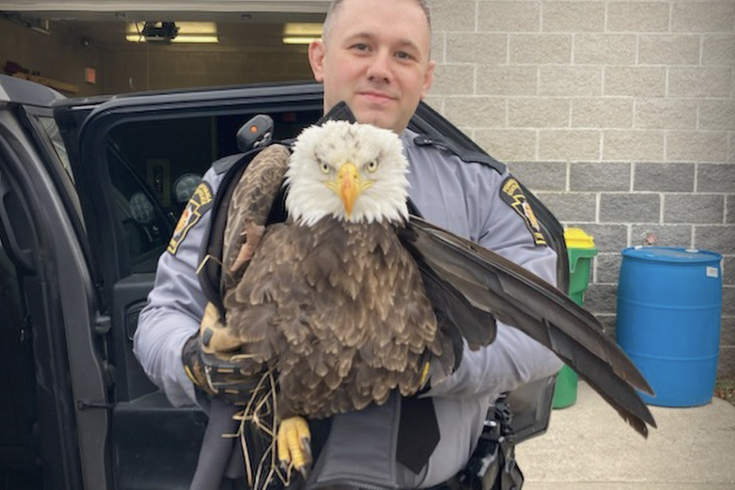
February 12, 2024
 PA State Police/Facebook
PA State Police/Facebook
Pennsylvania State Police rescued a bald eagle that was struck by a car in Perry County. The bird, which had an injured wing, is being treated a wildlife rehabilitation center.
A bald eagle that was hit by a car in Perry County is on the mend thanks to two Pennsylvania state troopers who stepped in to rescue the injured animal, officials said.
The eagle had been feeding along Route 322 in Greenwood Township, about 30 miles northwest of Harrisburg, when it was struck by a car, injuring its wing, state police said. No other details about the accident were released.
Troopers Alex Ebbert and Emilio Rizzo took the eagle to safety at the Newport barracks. Ebbert wrapped the eagle in his cruiser jacket and took a photo with the bird, which peered into the camera with a soul-piercing gaze. The eagle has since been taken to a wildlife rehabilitation center.
Troopers Ebbert and Rizzo responded to a report of a bald eagle hit on the roadway. Struck by a vehicle while feeding,...
Posted by PA State Police on Monday, February 12, 2024
Bald eagle populations in the U.S. have recovered since being decimated in the middle of the 20th century. Water pollution, illegal hunting, habitat loss and the use of harmful pesticides like DDT — which caused reproductive failure in many bird species — had left bald eagles severely threatened by the early 1960s. DDT was federally outlawed in 1972, followed by a number of other pesticides linked to environmental degradation. Around the same time, new conservation efforts emerged to protect wildlife habitats and restore the quality of waterways in the U.S.
The recovery of Pennsylvania's bald eagle population is one of the state's most successful conservation stories. There were just three bald eagle nests remaining in 1983, when the Pennsylvania Game Commission began its long-term restoration project. Now there are more than 300 nesting pairs, including at least one nest in all 67 counties.
To reintroduce the species, game commission employees flew to the Canadian province of Saskatchewan — where bald eagle populations were stable — to capture eaglets and bring them back to Pennsylvania with the hope that they would nest here when they were mature and ready to breed.
The Canadian wilderness missions were especially challenging because there was no GPS at the time. Biologists in the area had marked active nests on topographic maps and gave them to game commission staff, which used small floatplanes to search for the nests at these locations. Birds could only be taken if nests had more than one eaglet, since the parents needed to be left at least one to rear.
Over a seven-year period, 88 eagles were taken from Canada and introduced to habitats in Pennsylvania, where they've been monitored for decades as their populations recovered.
Nationally, the bald eagle population in the lower 48 states has roughly quadrupled since 2009, with about 317,000 of them recorded in 2021 by the U.S. Fish & Wildlife Service. In 1963, there were just 417 known nesting pairs in the country.
The bald eagle was removed from the federal Endangered Species List in 2007 and was taken off Pennsylvania's list in 2014. Surrounding states, including New Jersey, have had similar success restoring their bald eagle populations through dedicated programs in recent decades.
Pennsylvania and New Jersey each have bald eagle cams that give wildlife enthusiasts real-time glimpses at their nests. Pennsylvania's eagle cams are at Codorus State Park, near Hanover, and at an undisclosed location called Pennsylvania Farm Country.
Despite the restoration of bald eagle populations, hunting them remains prohibited under the federal Baid and Golden Eagle Protection Act and the Migratory Bird Treaty Act. Last year, a western Pennsylvania man was indicted by a federal grand jury for shooting and killing a bald eagle in Mount Pleasant Township, about 45 miles south of Pittsburgh. Penalties for violating the law include up to a year in prison and a fine of up to $5,000.
Hunters also are urged to take precautions against exposing eagles to lead, which is used in some ammunition and may be left behind in carcasses that eagles scavenge. The Pennsylvania Game Commission notes that as eagle populations increase, their chances of negative interactions with people also rise. In Georgia and other states, some ranchers now consider eagles menaces because they prey on pasture-raised chickens.
The Pennsylvania Game Commission celebrated the 30-year anniversary of the bald eagle restoration project with a short documentary on the history of the program, as well as how wildlife officials are responding to current dangers that impact bald eagles now that they're more abundant.